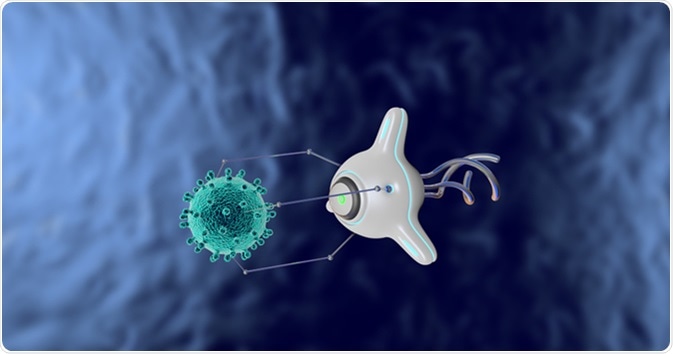Nanorobotic devices are anticipated to be among the most powerful tools ever created by humans. Also referred to as nanobots or nanorobots, these technologic devices range in size from 0.1 to 10 micrometers.
Nanotechnology uses machines that are specifically designed with components that are of a molecular or nano scale. A visualization of this scale can be made by comparing the size of our planet to a marble as a representation of the scale of one meter to one nanometer.
Nanorobots can be thought of like any other self-assembling robotic device (for example, those used for car assembly). The major difference, though, is that nanobots use the atomic building blocks of matter to assemble their products. Although this concept may be dismissed by some as science fiction, it may help to realize that, within our bodies are countless “nanobots” working in every action to keep our bodies functioning properly. However, we do not refer to these biologic entities as nanobots, but as cellular components that are responsible for DNA replication.

The Origins of Nanotechnology
As is often the case with many scientific and medical disciplines, applications of the concept of nanotechnology have been considered for centuries before the first formal definition was introduced. Many historians attribute the earliest systematic consideration of nanotechnology to American physicist, R. Feynman. In his 1959 speech titled, ‘There’s Plenty of Room at the Bottom,” Feynman outlined how things could be manipulated and controlled on a minute scale. He explained that this technology would broaden our understanding of complex situations and the strange phenomena that occur within the human body.
It was not until the second half of the 20th century that the term “nanotechnology” was coined by Japanese scientist N. Taniguchi. In 1974, Taniguchi published work regarding the use of technology to creates features and objects on the nanometer scale. However, the idea did not receive much attention until the late 1980s when K. Eric Drexler published a book on the topic. In his book, “Engines of Creation: The Coming Era of Nanotechnology,” he put forth the idea of a self-replicating nanomachine. In simple terms, this means a very small machine that is capable of creating other machines. According to Drexler, not only were these machines capable of creating more of themselves, but, because they were programmable, they could also create virtually anything else, especially because construction occurred at the atomic level.
Types of Nanobots
There are many different types of nanobots that are simply astonishing. For instance, researchers at the University of Cambridge have engineered an actuating nanotransducer (ANT) nano-engine that can produce one hundred times force per unit weight in comparison to any muscle or motor. Researchers are optimistic that these powerful nano-engines are a step in the direction of creating nanobots that are tiny and powerful enough to enter cells in vivo and combat diseases.
Several research groups have also constructed what may be referred to as nano-rockets. These remote-controlled, high-speed nanobots are capable of many feats, including delivery of pharmaceuticals to targeted areas within the body.
Other types of nanobots include 3D-DNA nanomachines, nano-swimmers, bacteria-nanobots, and sperm-like nanorobots. The 3D-DNA nanomachines are the brainchild of Ohio State University mechanical engineers, who made use of “DNA origami’ to construct complex mechanical parts on a nanoscale to use as components for future nanobots. Researchers at Technion and ETH Zurich have engineered nano-swimmers capable of maneuvering through physiologic fluids with the goal of using these for targeted therapy. Similarly, researchers from the Netherlands and Egypt have engineered sperm-like nanorobots that function under weak oscillating magnetic fields and may be utilized in the future for targeted therapy.
Applications of Nanotechnology
The possibilities with regards to nanotechnology are limitless and may go a long way to addressing contemporary global challenges and future dilemmas. This technology has significant potential to augment human biologic performance and create the elements for future sustainable population development, such as clean energy, food, and water. Moreover, the technology will be an important tool in treating a variety of medical conditions.
References
- http://journals.sagepub.com/doi/10.1177/0960327115603588
- https://aip.scitation.org/doi/10.1063/1.4880035
- https://phys.org/news/2016-04-nanomachines-medical-revolution.html
- http://www.pnas.org/content/early/2016/04/27/1524209113
- http://www.pnas.org/content/112/3/713
- https://aabme.asme.org/posts/the-rise-of-the-dna-nanorobots
Further Reading
- All Nanotechnology Content
- Nanoscience Advances in Biology
- Bionanotechnology Applications
- What are Nanoelectronic Biosensors?
- Nanoelectronic Biosensor Applications in Human Diseases
Last Updated: Oct 22, 2018

Written by
Dr. Damien Jonas Wilson
Dr. Damien Jonas Wilson is a medical doctor from St. Martin in the Carribean. He was awarded his Medical Degree (MD) from the University of Zagreb Teaching Hospital. His training in general medicine and surgery compliments his degree in biomolecular engineering (BASc.Eng.) from Utrecht, the Netherlands. During this degree, he completed a dissertation in the field of oncology at the Harvard Medical School/ Massachusetts General Hospital. Dr. Wilson currently works in the UK as a medical practitioner.
Source: Read Full Article



